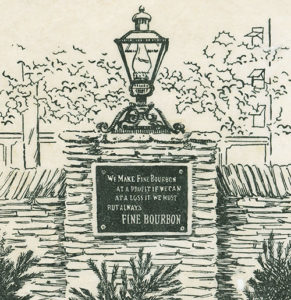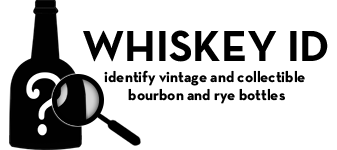
The famous plaque on the wall outside Stitzel Weller, as depicted on the tissue paper around a vintage bottle of Weller bourbon.
Why it’s revered
The Stitzel-Weller distillery has gained legendary status among bourbon connoisseurs for a number of reasons. First, it’s the distillery opened by Julian “Pappy” Van Winkle and run under his ownership for much of its history. When Pappy died his son Julian II took over, before it was sold and became just another corporate asset to be bought and sold numerous times.
Secondly, Stitzel-Weller exclusively produced a wheat-recipe bourbon that was developed by A. Ph. Stitzel, and consequently became the defining wheated bourbon thereafter. Maker’s Mark used a similar recipe and legend has it even borrowed yeast and distillery designs from Stitzel Weller when first starting. Today, the same style is carried on by Buffalo Trace and Heaven Hill for brands that were formerly produced at Stitzel Weller.
Third, most (but not all) of the whiskey that made the Pappy Van Winkle brand famous was distilled at Stitzel-Weller. Since Pappy Van Winkle led the most current bourbon craze, and the flavor profile has changed as of late, fans want to taste the old Stitzel Weller versions. Many Van Winkle fans have also embarked to find old bottles of Old Fitzgerald, Weller, and Rebel Yell so they can try some whiskey distilled when Pappy was running the business.
Finally, the distillery closed in 1992, and shuttered distilleries often take on a mystique and become larger than life.
Production Details
Stitzel Weller’s mash bill was reportedly 75% corn, 18% wheat, and 18% malted barley from its 1935 opening to around the time the distillery was sold by the family. After the sale, the mash bill was modified and eventually reached 75% corn, 20% wheat, 5% malted barley (enzymes were added at this time also). Under the Van Winkle family ownership there was a strict set of production methods: using jug yeast that was produced onsite, using open fermenters, not mashing under pressure, milling in roller mills, and using only spring water. Additionally, they used special barrels made of thicker oak that could take a deeper char, and required eight hoops instead of dix. Eventually after the sale some of these methods changed, including a switch to municipal water and a transition to bag yeast.
Master Distillers
Master distillers at Stitzel-Weller:
Will “Boss” McGill: 1935 – late 40s
Andrew J. “Andy” Corcoran: late 40s – early 50s
Roy Hawes: early 50s – 1971
Woodrow “Woody” Wilson: 1971 – 1983
Ed Foote: 1983 – 1992 (when he transitioned to Bernheim)
Timeline
There are certain milestones in the history of Stitzel Weller that are useful when dating bottles. Here’s a timeline of some of the more notable ones:
-1935- The Stitzel Weller distillery opened on Derby Day in 1935. Therefore any S-W whiskey bottled before 1939 will be distilled somewhere else. Prior to that it may have been distilled at A. Ph. Stitzel or elsewhere, as many barrels were being consolidated there before the new distillery was built.
-1962- Very Old Fitzgerald 10 and 12 year old started to be bonded products, due to an extension of the US Government bonding period from 8 to 20 years.
-1963- 10 and 12 year versions of Very Old Fitzgerald were renamed Very Xtra Old Fitzgerald and Very Very Old Fitzgerald, respectively.
-1964- Old Fitzgerald Prime was introduced at 86.8 proof, and was the first S-W product sold in the US at under 100 proof.
-1965- Julian “Pappy” Van Winkle died and his son Julian II took over as president. Many people covet the bottles that were distilled and bottled under Pappy’s ownership, although he was never a distiller himself.
-1972- The company and all its brands were sold to Norton-Simon Inc. as part of Somerset Imports, as part of a forced sale by stockholders. The distillery name was changed to Old Fitzgerald Distillery. After this point there were no longer any Van Winkles at the helm of the company, making pre-1972 bottles somewhat more sought after. Also in or around 1972, Cabin Still production shifted to a Canada Dry distillery, starting the decline in quality of the whiskey.
-1992- The Stitzel Weller distillery (at this point owned by United Distillers) closed early in the year and the distilling of the wheated brands was transferred to the new Bernheim distillery. Therefore the standard bottles of Old Fitzgerald up to around 1997 would have been S-W distilled, and Weller Antique would have most likely been at least partially S-W distilled until around 2000.
-1993- The Cabin Still brand was purchased by Heaven Hill and sold to Luxco.
-1999- The Old Fitzgerald brands were also sold to Heaven Hill, and the Weller brands were sold to the newly-named Buffalo Trace (formerly Ancient Age).
